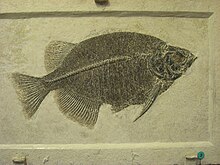| Phareodus | |
|---|---|
 | |
| Phareodus testis fossil, at the Buffalo Museum of Science | |
| Scientific classification | |
| Domain: | Eukaryota |
| Kingdom: | Animalia |
| Phylum: | Chordata |
| Class: | Actinopterygii |
| Order: | Osteoglossiformes |
| Family: | Osteoglossidae |
| Subfamily: | † Phareodontinae |
| Genus: | † Phareodus Leidy, 1873 |
| Type species | |
| Phareodus encaustus Cope, 1871 | |
| Other species | |
| |
| Synonyms | |
Dapedoglossus [1] | |
Phareodus is a genus of freshwater fish from the Paleocene to Eocene of North America.
This genus includes two species, [2] P. testis (Leidy, 1873) and P. encaustus of North America. Formerly included were P. muelleri of Europe, now accepted in the related genus Brychaetus as B. muelleri and P. queenslandicus of Australia which was later reassigned to Phareoides . [3] Representatives have been found in the middle Eocene of North America's Green River Formation in Wyoming, United States [1] and a tentatively identified Phareodus fossil was reported in 2023 from the Chuckanut Formation in Washington. [4]
Fossils similar to the genus have also been found in the Paleocene (Tiupampan) Santa Lucía Formation of Bolivia.
P. testis was a freshwater fish with an oval outline, a small head, and a slightly pointed snout. Its dorsal and anal fins were situated posteriorly, with the anal fin being larger. Its caudal fin was slightly forked. It had small pelvic fins but long, narrow pectoral fins. [1]



